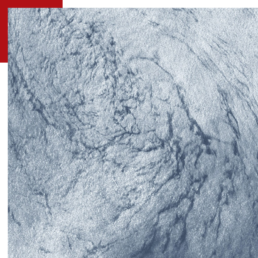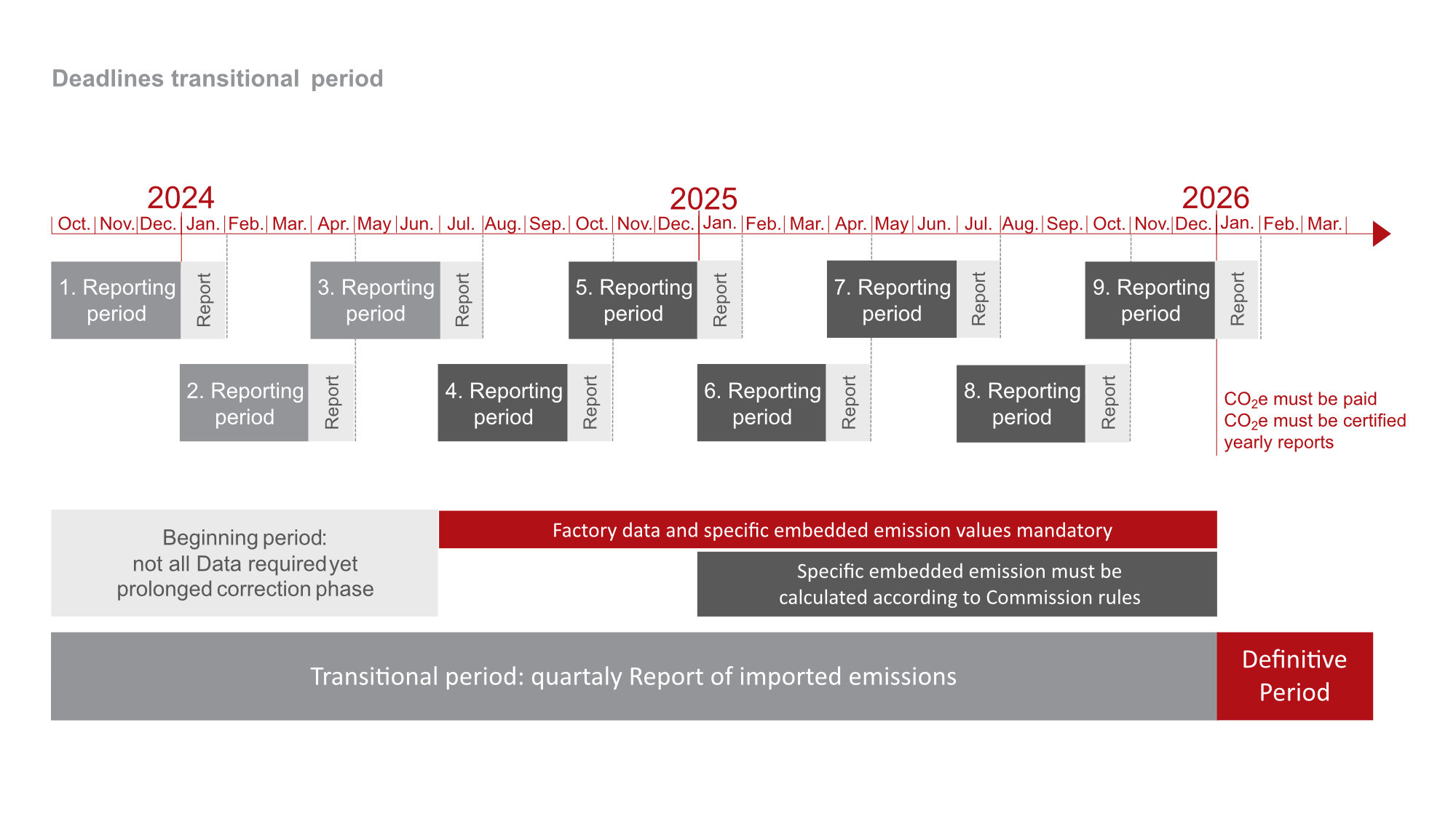Carbon Boarder Adjustment Mechanism - CBAM
European CO₂ - border adjustment mechanism for manufacturers and importers
As part of the European Union’s Fit for 55 programme, the established Carbon Boarder Adjustment Mechanism, CBAM for short, is seamlessly linked to the central European climate protection instrument, the European Emissions Trading System (EU ETS). Alongside the European Emissions Trading Scheme (EU ETS), CBAM is intended to minimise the risk of carbon leakage and support the EU ETS in its functioning. Carbon leakage describes the effect when companies based in the EU relocate their CO₂-intensive production processes to third countries outside the EU. With the aim of minimising carbon leakage and fairly accounting for the full emissions of products used in the EU, CBAM requires the affected sectors: cement, electricity, fertilisers, iron, steel and aluminium to disclose information on import volumes and producer emissions. From 2026, CO₂ costs will be gradually levied on the basis of the emissions reports to be submitted, which are based on the respective CO₂ certificate costs of the EU ETS.


Further information for manufacturers and importers
Since its launch in October 2023, the CO₂ border adjustment mechanism has required importers to disclose information on products subject to CBAM on a quarterly basis. In the background, companies subject to reporting requirements are within a transition period from October 2023 to December 2025, with simplified reporting obligations and no financial obligations. For standardized CBAM reporting, the EU Commission has provided the CBAM transition register, in which reporting entities must provide the relevant information on the quantity of goods, direct and indirect emissions and CO₂ costs already paid. The German Emissions Trading Authority (DEHSt) at the Federal Environment Agency has been appointed as the responsible authority within Germany.
For an overview of the most relevant information, you will find our CBAM presentation for all importers, suppliers and manufacturers below:
Here you can find more information about:
Questions and answers:
General information
What is CBAM?
CBAM is an acronym for: Carbon Border Adjustment Mechanism. It is a tool by the EU to mitigate the risk of “carbon leakage”. Carbon leakage describes the effect, when EU-based companies move their CO2-intensive production steps outside the EU to avoid the emission regulations like, paying a carob price in form of the EU emission trade system. Therefore, the EU-commission has put the CBAM regulation into place, to minimize the carbon leakage and to fairly account for the full emission of products used in the EU.
Which CN-codes are relevant for CBAM?
The CBAM regulation covers certain goods and selected precursors in the sectors: iron/steel, aluminum, fertilizers, cement, electricity and hydrogen. Here you can find a full list of all included CN-codes: LINK
I sort the item into a different CN-Code then the import? Which CN-code applies?
Since the CBAM report is link with the customs declaration, the CN-code assigned by the EU-importer is the one to consider. If the importer decides to place an item under a CBAM relevant CN-code, this good is CBAM relevant and the importer will request the necessary information from you.
What is the CBAM transitional period?
The time from October 2023 until December 2025 is called the CBAM transitional period. During this period the importers are asked to provide the European commission with information about how much CO2 emission are created on their behalf in EU-third countries. The main purpose of this period is to establish the assessment of CO2 emissions at the manufacturer level und to give the EU-commission a better idea of the extend of the CO2 emission created in EU-third countries for products used in the EU in the end. From 2026 the CBAM-definite period will come into effect. During the definite period, the CO2 emission created outside the EU will be subject to a carbon price, similar to the EU-emission-trading-system.
What time period is covered by the current CBAM report?
During the transitional period the CBAM report has to be submitted for each quarter year. The first CBAM reporting period covers the time from October 2023 until December 2023, the next period is January 24 until March 24 and so on. The table provided under the following link shows the CBAM reporting periods and the deadlines of the corresponding CBAM reports. LINK
Who has to prepare a CBAM report?
Any importer based in the EU, who imports CBAM-relevant goods from outside the EU into the EU needs to preparer a CBAM-report. If they don’t or are not able to, the European commission may impose penalties.
Questions and answers:
General information
Who is a supplier?
A supplier is someone who purchases goods and resells those. They are not operating the Installations in which those goods are manufactured.
Who is the Operator?
In the CBAM-wording, the Operator is the company that is running one or more Installations in which CBAM-goods are manufactured.
What is an Installation?
The Installation refers to the factory or process route, in which CBAM-goods are manufactured. It is not necessary to name all machines/tools involved, it is only required to refer to the entire installation. Packaging and assembling sites are not regarded as a CBAM-relevant Installation.
Is an assembling/packaging site a CBAM-relevant Installation?
No. The Installation relevant for CBAM is the last Installation, in which actual changes to the goods are executed (e.g. Rolling, melting, cutting, …). Packaging and assembling of different parts are not regarded as actual changes to the goods.
Is each individual tool/machine within one process route an Installation?
No. The installation is composed of all machines/tools necessary to complete the manufacturing of a good. An Installation for Iron and steel goods can for example be composed of: a blast furnace, a steelmaking process (e.g. Linz-Donawitz steelmaking) and a hot rolling process. It is not necessary to name all machines/tools involved, it is only required to refer to the entire installation.
What are the standard emission values?
In the beginning of the CBAM transitional period (first three reports) it is allowed to use standard emission values instead of specific emission values (describe the specific emission of the producing factory). The EU-commission has published a list of standard emission value based on the CN-Code. You can find this list here: LINK The standard emission values can be used unrestricted for the first three reports. Afterwards a good reason needs to be provided, if the standard values are to be used.
Specific information for manufacturers and suppliers
What are specific embedded emissions?
The term specific embedded emission refers to the CO2 emissions, which arise during the manufacturing of a good, e.g. if the burning of fossil fuels is necessary during the production or if electricity is necessary (which often is produced by CO2 emitting processes). It means that the manufacturing of this item has produce a certain amount of CO2 emissions, which should be allocated to this good, in order to keep track of the produce CO2 emissions.
How do I determine the specific embedded emission of a good?
There are different possible ways to determine specific embedded emission of goods. The following question covers which methods are approved by the EU-commission. In general the embedded CO2 emission can be directly measured or calculated based on the stream of source material, the activity level and some scientific assumptions. The EU-commission has provided a tool, which can be used to determine the emission value based on the material flow. You can find this tool here: LINK
Which method can I use to determine the specific embedded emission of goods produced at my installation?
Until December 31st 2024 the following methods to determine the specific emission value are approved:
- a carbon pricing scheme where the installation is located;
- a compulsory emission monitoring scheme where the installation is located;
- an emission monitoring scheme at the installation, which can include verification by an accredited verifier;
- determining emissions from source streams on the basis of activity data obtained by means of measurement systems and calculation factors from laboratory analyses or standard values;
- determining emissions from emission sources by means of continuous measurement of the concentration of the relevant greenhouse gas in the flue gas and of the flue gas flow.
After January 1st 2025 only the last two listed methods are permitted.
What is a UUID?
A UUID is a Universally Unique Identifier. It is a series of numbers, letters and dashes, which is, as the name suggests, unique. We use the UUID to correlate purchases to one specific Installation and one specific Operator. You are asked to general such a UUID in the document B_Base_Data and use the same one in all other documents (01_purchase_list..., C_Emission_Data).
Here you can find a document, what shows which UUID should be used in the document 01_purchase_list…: LINK
CBAM deadlines to be met by 2026


Our offer to you:
You can find more information about our company here:

